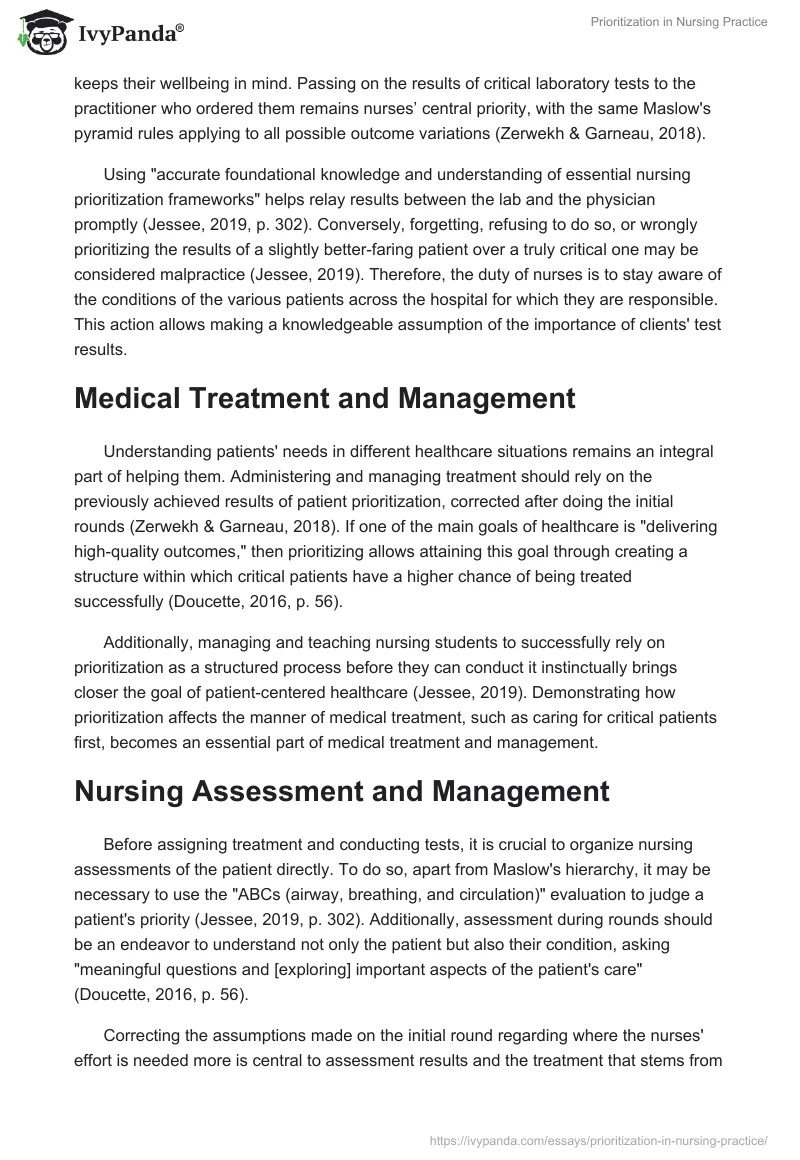Paperwork, patients, hospital rounds, interns, and keeping morale up are a part of nurses’ reality throughout their practice. Identifying at a glance which tasks and patients require immediate attention and which can be attended to at a later time is an essential aspect of the profession. Without prioritization, it may be impossible to create an experience that is genuinely patient-oriented and focused on the needs of various clients.
Concentrating on a list consisting of “safety, quality, and service” could be the key to achieving better prioritization practices in nursing (Doucette, 2016, p. 56). Therefore, understanding how to engage with everyday nursing tasks in a professional manner could help not only increase customer satisfaction but also assist healthcare professionals in reducing their stress levels and focus on their work.
Definition
Prioritization relies on nurses’ understanding of patients’ current conditions and what can be done to help them, as well as at what expense. Relying on Maslow’s hierarchy of needs becomes an indispensable support structure when identifying those who require immediate attention, rather than adhering to a first-come-first-serve basis (Zerwekh & Garneau, 2018). Thus, prioritization is the act of determining who to help based on clients’ position on Maslow’s needs pyramid, the results of which “may change as complete your initial assessments” (Zerwekh & Garneau, 2018, p. 245).
Furthermore, it is an essential skill that helps balance various severe cases in hospitals and facilities, creating a guiding line for nurses who would otherwise be forced to sacrifice other aspects of care (Jessee, 2019). Therefore, without prioritization, it may not be possible for nurses to create a day plan that reflects the needs of all admitted clients.
Laboratory and Diagnostic Tests
Communication remains vital in every hospital situation; without which it may be impossible to work effectively and provide clients with quick and competent service that keeps their wellbeing in mind. Passing on the results of critical laboratory tests to the practitioner who ordered them remains nurses’ central priority, with the same Maslow’s pyramid rules applying to all possible outcome variations (Zerwekh & Garneau, 2018).
Using “accurate foundational knowledge and understanding of essential nursing prioritization frameworks” helps relay results between the lab and the physician promptly (Jessee, 2019, p. 302). Conversely, forgetting, refusing to do so, or wrongly prioritizing the results of a slightly better-faring patient over a truly critical one may be considered malpractice (Jessee, 2019). Therefore, the duty of nurses is to stay aware of the conditions of the various patients across the hospital for which they are responsible. This action allows making a knowledgeable assumption of the importance of clients’ test results.
Medical Treatment and Management
Understanding patients’ needs in different healthcare situations remains an integral part of helping them. Administering and managing treatment should rely on the previously achieved results of patient prioritization, corrected after doing the initial rounds (Zerwekh & Garneau, 2018). If one of the main goals of healthcare is “delivering high-quality outcomes,” then prioritizing allows attaining this goal through creating a structure within which critical patients have a higher chance of being treated successfully (Doucette, 2016, p. 56).
Additionally, managing and teaching nursing students to successfully rely on prioritization as a structured process before they can conduct it instinctually brings closer the goal of patient-centered healthcare (Jessee, 2019). Demonstrating how prioritization affects the manner of medical treatment, such as caring for critical patients first, becomes an essential part of medical treatment and management.
Nursing Assessment and Management
Before assigning treatment and conducting tests, it is crucial to organize nursing assessments of the patient directly. To do so, apart from Maslow’s hierarchy, it may be necessary to use the “ABCs (airway, breathing, and circulation)” evaluation to judge a patient’s priority (Jessee, 2019, p. 302). Additionally, assessment during rounds should be an endeavor to understand not only the patient but also their condition, asking “meaningful questions and [exploring] important aspects of the patient’s care” (Doucette, 2016, p. 56).
Correcting the assumptions made on the initial round regarding where the nurses’ effort is needed more is central to assessment results and the treatment that stems from it (Zerwekh & Garneau, 2018). Without prioritization, nursing assessment stops being an act that covers the whole hospital but instead becomes a case-by-case evaluation of an individual patient whose treatment is disjointed from others around him, making the process self-centered.
Conclusion
Prioritization remains an integral part of many healthcare processes, creating the prerequisites for proper treatment that keep the consumer in mind. Integrating it into every aspect of healthcare permits attaining a better environment within which wellness is a more prevalent outcome, and critical patients are included in the care mechanism based on their needs. Furthermore, while it is not a fail-proof method and, additionally, one that must be taught and apperceived, the effort put into teaching prioritization techniques to students through their demonstration may influence their work ethic positively.
This approach to healthcare may allow the nurse to guide patients to wellness as part of a process, rather than excluding them because they arrived at the hospital later than others. Therefore, prioritization permits facilities and their nurses to remain both patient-centered and achieve better wellness results.
References
Doucette, J. N. (2016). Prioritize the patient experience. Nursing Management, 47(11), 56. Web.
Jessee, M. A. (2019). Teaching prioritization: “Who, what, & why?”. Journal of Nursing Education, 58(5), 302-305. Web.
Zerwekh, J., & Garneau, A. Z. (2018). Nursing today: Transition and trends (9th ed.). St. Louis, MO: Elsevier Health Sciences.


